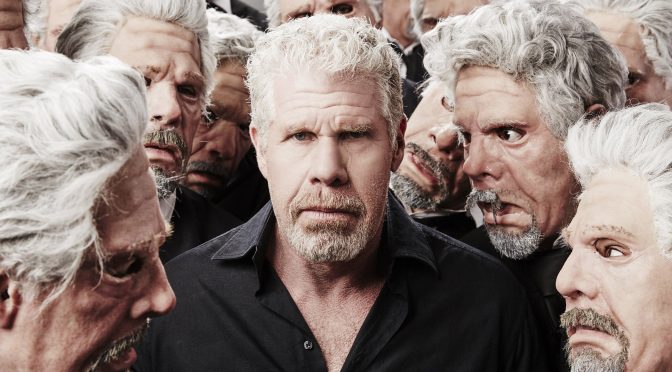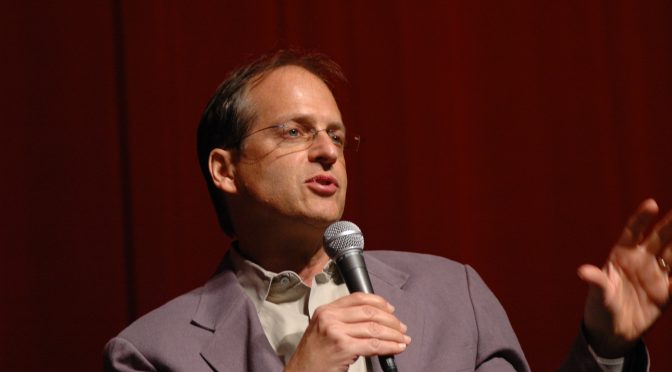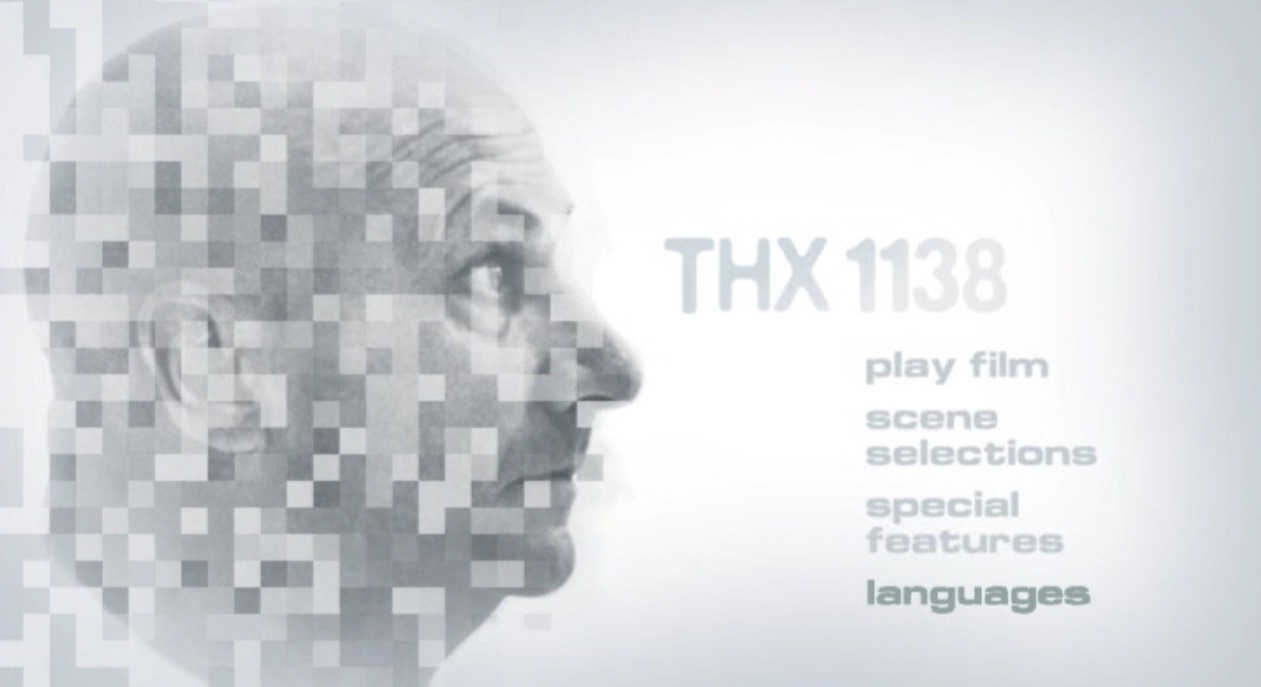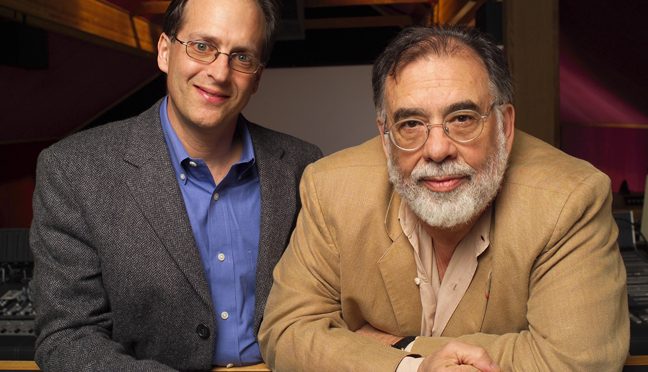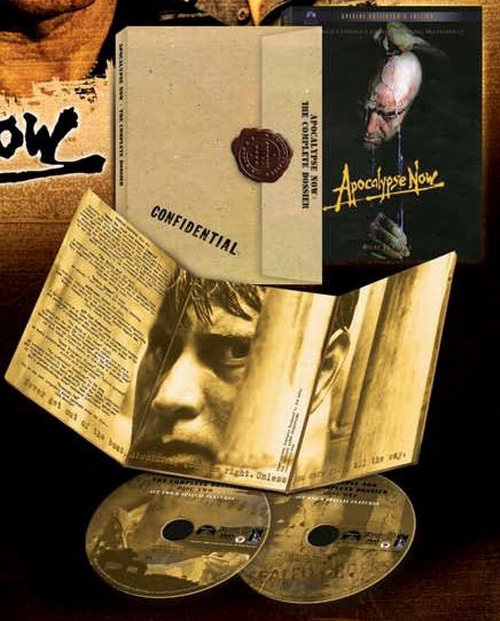Dans la lointaine Guerre du Feu il courait après un feu encore divin. Dans Hellboy il interprète un démon humaniste jouant avec le feu de l’enfer. Lucide, Ron Perlman ne s’enflamme pas au moment où son nom s’inscrit enfin en haut de l’affiche.
Note : Rencontrer et interviewer Ron Perlman fut pour moi un grand moment de cinéphile. Hellboy le mettait enfin tout en haut de l’affiche et il est depuis devenu aussi star de plusieurs séries TV, mais dans les faits, avant 2004 et Hellboy, sa présence à l’écran n’était appréciée que par une poignée de spectateurs (et de réalisateurs) attentifs. Le petit regard malicieux de côté retenu depuis son personnage de La Guerre du feu ? Il appartient en propre à Ron Perlman. Derrière un physique imposant et un sourire carnassier, Ron Perlman dégage une intelligence aussi vive que sa franchise et son humour. Il se prétend forçat de l’acting, travailler pour payer son toit et faire manger sa famille, mais la longévité de sa carrière et un bon nombre de ses films prouvent surtout un talent durable et reconnu par les metteurs en scène (sa filmographie ici). Il a supporté la charge de mes questions avec beaucoup de sportivité, de malice et encore une fois, de franchise. Une liberté de parole et de pensée qu’il exerce sans détour sur twitter pour dénoncer, entres autres forfaitures, l’administration Trump des années 2017. Voir par exemple cette prise de parole lors d’une interview en août 2017. On recommande vivement de le suivre ici… Même si cela arrive bien tardivement, je suis content de mettre ici l’intégralité de cet entretien qui regorge de détails et d’anecdotes sur la collaboration de Perlman avec del Toro et Jean-Jacques Annaud. Même en français. On y entend aussi une personnalité qui mélange assez inhabituellement coolitude et détermination. J’étais le dernier à l’interviewer seul ce jour ce 5 août 2004, et alors qu’une attachée de presse nous faisait des signes pour, j’imagine, arrêter l’interview en cours, je me suis tourné candidement vers Ron Perlman pour lui demander…
– Vous pouvez m’accorder encore un peu de temps ?
– (Il regarde ma pile de feuilles avec une quarantaine de questions…) Oui, vous êtes ma dernière interview alors vous pouvez avoir le temps dont vous avez besoin.
– Vraiment ?
– Ouais.
Et l’interview s’est arrêtée naturellement sur la meilleure réponse qu’il pouvait donner à ma dernière question…

Ron Perlman, l’interview intégrale Hellboy et carrière
Bliss : Depuis vos mémorables prestations des années 80 dans la Guerre du Feu et Le Nom de la Rose on vous attend en haut de l’affiche. Vous auriez pu jouer un aventurier, un highlander, ou même un vilain récurrent… Pourquoi tout ce temps ?
Ron Perlman : Oui, moi aussi je l’attendais. J’ai toujours été lent, plus lent que les autres. Je ne sais pas, ce n’est pas venu vers moi. Tout ce qui est venu à moi, est sur l’écran. Je n’ai jamais rien refusé parce ce que je n’ai pas assez de propositions pour avoir le luxe de dire non. La plupart du temps, je suis embarrassé de ce qu’il y a à l’écran. J’essaie juste de gagner ma vie, de mettre mes enfants à l’école. Jusqu’à ce jour, même avec Hellboy, Hollywood ne m’a jamais compris. Ils ont certainement une idée différente que vous et moi.
Bliss : Vous avez un statut d’acteur culte en France. Êtes-vous confortable avec cette image ?
Ron Perlman : Très. Franchement j’aurais aimé avoir plus d’opportunités, mais n’enlevons rien au fait que toutes les choses dont je suis le plus fier ont été réalisées par deux metteurs en scène français, Jean-Jacques Annaud pour la Guerre du feu et Le Nom de la rose, Jean-Pierre Jeunet pour La Cité des Enfants Perdus et Alien Resurrection, puis un mexicain avec Guillermo Del Toro sur Hellboy. Je suis reconnaissant qu’ils soient rentrés dans ma vie et qu’ils m’aient invité à participer à leur si importants films. Vous savez, ils sont ma carrière, quand je regarde en arrière et le sentiment de satisfaction vient des travaux de ces trois types. Je suis à un point maintenant où j’ai beaucoup de paix intérieure et d’auto satisfaction d’avoir eu l’occasion de faire des alliances extraordinaires avec des gens très très brillants et que du bon boulot en soit sorti.
Bliss : Vous avez dorénavant joué aux deux extrêmes des possibilités du cinéma : il y a 23 ans presque tout nu dehors en hiver dans La Guerre du feu, et, dans Hellboy, en studio recouvert de maquillage des pieds à la tête et face à des écrans verts où seront incrustés des décors plus tard. Que préférez-vous ?
Ron Perlman : Del Toro n’utilise pas autant d’écrans verts que vous croyez. Il met toujours une vraie image dans le cadre. Il l’augmentera, l’améliorera. J’ai donc eu la chance de ne pas jouer Roger Rabbit dans un univers complètement imaginaire. C’était dur sur La Guerre du Feu, très dur. Mais je rentrais très satisfait du challenge chaque soir. Vous n’êtes pas supposé être confortable ou vous amuser tout le temps. C’est normal. La vie est comme ça. Après tout, les films sont en quelque sorte le miroir de la condition humaine. La Guerre du Feu a été vraiment très dur à faire et probablement l’expérience la plus satisfaisante de ma vie à ce jour. Parce que nous avons relevé le défi. Nous avons fait face à la difficulté. Et c’est ce dont vous gardez le souvenir.
Bliss : Vous avez commencé en interprétant un homme préhistorique, cela a aidé ou handicapé le début de votre carrière ?
Ron Perlman : Cela ne l’a certainement pas aidée. Écoutez, quand vous commencez en tant qu’acteur, vous ne savez pas si vous allez avoir ou pas une carrière. Alors La Guerre du Feu était mon premier film et je fais toujours des films alors cela a du aider, cela m’a mis un pied dans l’industrie du cinéma. Est-ce que cela m’a conduit directement à un quelconque autre rôle ? Je ne sais pas, peut-être que oui, peut-être que non. Je vais vous dire à quoi cela m’a conduit directement : au Nom de la Rose (5 ans plus tard tout de même, ndlr). Parce que si je n’avais pas fait La Guerre du Feu je n’aurais certainement pas fait le Nom de la Rose et Enemy at the Gates. C’était le début de cette relation avec Jean-Jacques Annaud qui a été un élément très important dans ma carrière.
Bliss : Votre participation au Nom de la Rose s’est pourtant décidée de justesse…
Ron Perlman : Le rôle avait été donné à quelqu’un d’autre pour des raisons politiques (Annaud explique que cette coproduction européenne ne devait pas faire appel à des acteurs américains, sauf en cas de coup dur, ndlr). Tel que je l’ai compris, le film était une coproduction entre l’Allemagne et l’Italie. Alors à un moment donné le gouvernement italien qui y mettait de l’argent a demandé : qui sont les acteurs italiens dans le film ? Et Jean-Jacques a dit : euuuh, euuuuh, euuuh, on n’en n’a aucun. Alors ils ont dit : mais quels rôles sont encore disponibles ? Et il répond, eeeuuh, il voulait vraiment que je joue Salavatore mais il dit : eh bien le rôle de Salvatore est toujours libre. Alors ils ont dit : soit vous utilisez un acteur italien pour Salvatore soit on retire nos deux millions de dollars. Alors il a engagé un acteur italien qui a commencé a très mal se comporter. Il n’est pas venu à un essai de costume, il n’est pas venu pour une coupe de cheveux, il se conduisait comme un vrai imbecile. Alors finalement, 3 jours avant de commencer à tourner, Jean-Jacques reçoit un coup de fil lui disant que cet acteur refuse de se couper les cheveux (tous les acteurs ont du subir la tonsure des moines, ndlr) et réclame deux fois plus d’argent pour se les faire couper. Jean-Jacques a tourné son dos au type et dit : s’il ne sort pas du plateau dans les 5 minutes, je vais aller jusqu’à ma voiture, attraper un flingue et tuer cet enfoiré (mother fucker) (je paraphrase). Mais Bernd Eichinger qui produisait le film a calmé Jean-Jacques : il est engagé, il doit tourner dans trois jours. Et Jean-Jacques répond : il ne tourne pas dans trois jours, je ne tourne pas dans trois jours s’il joue Salvatore. Et Bernd Eichinger lui demande : tu as un 2e choix ? IL EST mon second choix, mon premier choix dort en ce moment à Los Angeles. Et il ouvre son carnet d’adresse et dit : voilà son numéro de téléphone. Et à 5h15 du matin, mon téléphone sonne. Une minute après l’incident en Allemagne. Et on me dit : on a besoin du numéro de téléphone de ton agent, nous sommes sur le point de te faire une offre pour Le Nom de la Rose, mais doit conclure le deal d’ici une heure parce que tu dois être dans un avion dans trois heures. Et à 5H15 du matin, l’affaire était conclue.
Bliss : Votre personnage de moine simplet du Nom de la Rose s’exprime dans une langue bizarre cosmopolite… Était-ce dans le scénario ?
Ron Perlman : Ce n’était pas écrit, non. Jean-Jacques n’en parle pas dans le DVD (non, ndlr) ? Arrivé sur le tournage il m’apprend : « Je n’ai pas mis les dialogues que je voulais dans le script pour ne pas effrayer les gens qui financent le film, mais je veux que Salvatore parle tout le temps. C’est à toi de jouer. » Le livre d’Umberto Eco a été traduit dans environ 88 langues. J’ai mis la main sur six exemplaires de langues différentes. J’ai cherché les pages où Salvatore parle et j’ai reconstitué des dialogues – ou plutôt un « écho de dialogues » – en utilisant les différentes langues. Puis j’ai pioché au hasard : un premier mot en allemand, puis un mot en italien, un autre en espagnol, un en français, et j’ai jeté du latin dans le mixe. Jean-Jacques ne savait pas ce que j’allais faire jusqu’au moment de tourner. Quand Salvatore s’est mit à parler, je l’ai vu sourire. Je crois qu’il était plutôt réjouit de la décoction.
Bliss : Rick Baker, le célèbre responsable des maquillages vous avait recommandé pour jouer dans la version de Tim Burton de la Planète des Singes. Pourquoi cela ne s’est-il pas fait ?
Ron Perlman : Burton ne le sentait pas. Je ne l’ai jamais rencontré. Il n’a même pas voulu que j’auditionne. Il a refusé même de me rencontrer. Rick voulait que je joue le rôle que Michel Clarke Duncan a fini par jouer (le gorille Colonel Attar, ndlr).
Bliss : Vous semblez avoir un certain flegme et même du recul par rapport à votre métier…
Ron Perlman : Vous savez je n’ai jamais commencé pour devenir une star de cinéma. Et j’ai toujours été très réaliste par rapport à ce qui était faisable ou pas. Et j’ai autant de satisfaction à jouer un super rôle dans une seule scène d’un film qu’un simple bon rôle dans 46 scènes d’un film. Plus de satisfaction même quelque fois parce que souvent le résultat est mieux. Tout ce qui se passe au-delà de ce paradigme est un cadeau. Hellboy a été cet incroyable cadeau qui – il faut que vous me croyez quand je vous le dit – je crois encore que je vais me réveiller un jour et découvrir que tout ça a été un rêve. Cela n’aurait pas du arriver, cela n’était fait pour arriver. C’était une chose impossible de convaincre un studio de signer un très gros chèque sur un type qui n’avait aucune référence en tant que movie star. Et soyons lucide, c’est leur logique d’assurance. Ils n’ont pas tant de choses que ça à leur disposition qui puissent leur garantir un succès excepté que l’illusion que si vous êtes déjà passé par là, si vous avez la trace que vous êtes une entité qui engrange de l’argent vos chances sont plus grandes. C’est la façon dont les choses se font. Je ne le prends pas personnellement, je ne crois pas que cela soit difficile à comprendre, ce n’est certainement pas une malédiction me visant, je ne crois pas que qui que se soit souhaite que je tombe malade (me souhaite du mal), c’est juste la réalité et je le crois vraiment…
Bliss : Vous pensez que del Toro fait partie des 4-5 meilleurs réalisateurs au monde. Qui sont les autres pour vous ?
Ron Perlman : Pour moi, le plus grand réalisateur de film est Francis Ford Coppola. Et même s’il n’a pas fait un film depuis longtemps et même quand il ne travaille pas, il est toujours le meilleur. Tant qu’il est vivant, il est le meilleur réalisateur sur Terre. Je crois que Paul Thomas Anderson est un cinéaste important (Magnolia, Punch Drunk Love, There Will Blood…, ndr).
Bliss : Vous n’allez jamais frapper à leurs portes ?
Ron Perlman : Non, je ne sais pas où sont ces portes, mais si je savais peut-être que je le ferais. J’aimerais travailler avec le réalisateur brésilien qui a fait La cité de Dieu (Katia Lund et Fernando Meirelles, ndlr), avec Pedro Almodovar. Je liste ici mes films préférés des 5 dernières années.
Bliss : Vous citez essentiellement des réalisateurs de films indépendants ou européens, guère de Hollywood…
Ron Perlman : Je n’ai pas vu un film hollywoodien que j’ai aimé depuis un bon moment. Ridley Scott se place juste après Francis (Coppola). Il est numéro 2, peut-être numéro 1, mais c’est proche, difficile de décider.
Bliss : Le fameux site Internet Movie Data Base indique que votre film favori est Nobody’s Fool (Robert Benton, 1994), pourquoi celui-là ?
Ron Perlman : C’est l’un de mes films préférés oui. Le film fait 2h, j’aurais pu le regarder pendant 7 heures d’affilées.
Bliss : A cause de Paul Newman ? Melanie Griffith ?
Ah oui ses seins (voir la fameuse, pour certains, scène ici) ! Ils sont bien dans ce petit flash. Non mais c’est tout le monde faisant un incroyable bon boulot, subtil, intelligent, rempli d’esprit et, il n’y a pas d’intrigue, c’est purement un film de personnages. C’est exactement le genre de film qui m’intéresse le plus.
Bliss : Pour en revenir à Hellboy, vous vous êtes entrainé physiquement avant le tournage ?
Ron Perlman : Oui, j’ai pensé qu’il était important que je sois dans la meilleure condition physique possible. Mais je n’ai pas eu à apprendre quelque chose en particulier comme une forme de combat spécifique ou autre comme Tom Cruise a fait pour Le Dernier Samouraï. J’ai juste été à la salle de gym parce que le tournage allait être long comme une course d’endurance : courir, sauter et frapper.
Bliss : N’avez-vous pas été frustré justement que l’on vous applique des muscles en plastique et un masque qui cache votre visage et vos expressions ? D’autant que l’idée est de montrer un Hellboy humain ?
Ron Perlman : Non non, pas quand on comprend la nature de que l’on doit exprimer et du physique que l’on doit incarner qui a été totalement inventé par Mike Mignola (auteur du comic book Hellboy, ndlr). En plus avec un metteur en scène vraiment énorme fan du travail de Mignola mon exercice consistait à rendre hommage à l’univers qu’il avait créé, pas à l’améliorer, ou à en profiter pour en faire plus ou pour y appliquer un rif de jazz en disant : « ceci est mon comic book film ». C’est ça l’exercice et le faire aussi purement et honnêtement que possible et rester dans cet esprit aussi spécial soit-il. J’adore le processus et jamais ça ne me dérange d’être recouvert, méconnaissable. Le personnage est montré à un point que j’ai ressenti comme étant le mieux concrétisé de tous ceux que j’ai pu jouer. A cause du cœur du type. Par là où tout passe, ce qui est le plus important. Il s’agissait d’introduire au monde un vrai et nouveau mythe, quelqu’un qui ne ressemble pas aux autres, qui n’a pas le même câblage que les autres mais qui a une profonde et magnanime présence. Un personnage poignant parce que la part d’humanité à laquelle il ne participe pas est celle où il aspire à participer justement, parce qu’il est un freak.
Bliss : Pourquoi ne pas avoir participé aux éditions spéciales de La Guerre du Feu et du Nom de la Rose parues en DVD en France ?
Ron Perlman : Mais j’ai travaillé sur La Guerre du Feu ! J’ai enregistré un commentaire audio (ce commentaire audio collectif des acteurs apparaît sur le Zone 1 mais pas sur le collector Zone 2, ndlr). Je ne sais pas pourquoi je n’ai pas participé au Nom de la Rose, j’étais probablement assis à Hollywood à ne rien faire. Mais je ne savais même pas que c’était en DVD jusqu’à ce que quelqu’un me le mette sous le nez en me demandant de le signer.
Bliss : Êtes-vous obligé de participer à l’élaboration des suppléments d’un DVD, touchez-vous un cachet supplémentaire ?
Ron Perlman : Je suis un membre de la Screen Actor’s Guild (Syndicat des acteurs professionnels créé en 1933, ndr), il existe une formule pour la participation à la vente d’un DVD, alors je suppose que à un moment je recevrais un chèque qui me dira si le DVD a été un succès. Cela ne me permettra pas de prendre ma retraite, ni de laisser de l’argent à mes grand enfants, mais ce sera un gentil chèque. Sinon je ne suis pas obligé de vous parler, je ne suis pas obligé de faire le DVD, la seule obligatoire sur mon contrat est de faire le film. Mais vous faites ces choses parce que vous êtes fiers du travail que vous avez accompli et vous voulez partager le produit avec le public. Ce n’est pas du tout à propos de l’argent, il s’agit d’enthousiasme, de fierté et de désir de vous assurer que vous aurez la plus grande audience possible.
Bliss : Néanmoins, tel qu’on le voit sur le DVD, pour le bien du futur documentaire, vous êtes filmé en permanence sur le plateau, même quand vous ne jouez pas. N’est-ce pas perturbant pour la concentration, le confort, on vous filme en train de tousser, de vous gratter ? On vous voit même roter ! L’espace de repos théorique avant les commandes Action et Coupez n’existe plus pour les acteurs à cause des making of des DVD…
Ron Perlman : Oui, le documentariste m’immortalise pour toujours… Et on espère que les grattements seront utilisés judicieusement. Je n’ai pas de contrôle sur le contenu du documentaire. Mais de toutes façons je n’ai pas le contrôle de la performance que je donne pour le film non plus. Ils se servent des outils que j’ai fourni quand ils ont filmé la scène et l’éditent pour servir leur vision de la scène. Ma vision de la scène quand je la joue peut-être très différente de celle du réalisateur et des monteurs. En fait j’ai vu une grande partie de mon travail utilisé totalement hors du contexte que je croyais être quand je peaufinais la performance. Et on se retrouve avec un produit final qui ne correspond pas à vos intentions initiales. Ça peut tout fiche en l’air et transformer tel type de performance en une performance complètement différente. Quelque fois cela la rend meilleure et parfois cela la rend absolument insupportable à voir.
Bliss : Les scènes coupées et les éventuelles prises alternatives présentes sur le DVD devraient vous soulager en montrant plus de votre travail, non ?
Ron Perlman : Oh il y a des choses que j’ai vu dans les documentaires qui me font grincer, comme de me voir fumer une cigarette entre deux prises ou avoir une conversation qui n’était pas censée être enregistrée. Certains aspects de moi sont révélés que j’aurais préférés ne pas montrer. Mais c’est le business. Vous priez et espérez être entouré de gens qui ont du goût et qui ne feront rien qui puissent compromettre le produit ou les gens impliqués. S’il y a deux personnes auquel je fais confiance comme à personne d’autres ce sont Jean-Jacques Annaud et Guillermo Del Toro. Comme Guillermo était impliqué dans tous les aspects du DVD, je n’ai pas besoin d’aller voir si je m’en sors bien dedans. Je sais que s’il a choisi c’est que ça doit être ok. Je lui fais confiance.
Bliss : Dans le making-of de Hellboy vous faites une blague au réalisateur en lui faisant croire que votre téléphone portable sonne pour lui. Vous avez eu du mal à avoir son attention pendant le tournage ?
Ron Perlman : J’ai toujours eu son attention. Je ne jouais pas Hellboy, nous le jouions ensemble. Guillermo jouait Hellboy en même temps que moi. Il est fasciné par le personnage au point d’y voir beaucoup de lui-même. Je n’étais qu’un instrument. Nous n’avons pas beaucoup répété et ça me va très bien. Quand nous avons effectivement un peu répété, je n’ai pas tout à fait révélé ce que j’allais faire quand la caméra allait tourner. Au début quand il a commencé à me diriger je lui ai dit : laisse moi le faire une fois que je sorte cette idée de ma tête et ensuite on peut modifier comme tu le veux. Et aussitôt filmé le premier essai il criait : « ok c’est bon ! » Ce n’était pas ce qu’il avait envisagé mais tout le monde aimait… De là est né cette incroyable appréciation mutuelle. Quand il était important pour lui d’avoir une scène jouée très précisément comme il le voulait pour le montage ou pour la forme de la séquence, il intervenait. Mais la plupart du temps il était très intéressé de voir ce qu’allait donner mon interprétation du personnage. Sa vision était très claire sur la page, c’est pourquoi je voulais une chance de le jouer comme je m’en rappelais la première fois que l’ai lu. Parce que c’était la meilleure description d’un personnage que j’ai jamais lu. La façon dont il bougeait, dont il parlait, dont il se déplaçait était d’une grande clarté dans mon esprit. Je ne cherchais pas à être un control freak, je voulais lui montrer ma réponse instinctive de ce que j’ai ressenti la première fois que l’ai lu. Et je n’y ai pas travaillé. Je ne me suis pas préparé. Putain je n’ai lu le script qu’une seule fois !
Bliss : Et le comic book ?
Ron Perlman : Le personnage était différent, mais le script… Sans me préparer, sans répéter, je voulais le jouer, putain, comme ça sortait. Et en général j’ai obtenu un sourire de lui, ou une tape sur l »épaule : « How the fuck did you come up with that ». La seule fois où nous avons eu une dispute c’est quand il a voulu changer quelque chose qu’il avait écrit. Je luis ai dit : non non non tu avais raison la première fois. Ce fut la seule fois où lui et moi avons vraiment été en désaccord. La plupart du temps nos discussions duraient 15 secondes. Mais cette discussion a duré et a fini par chauffer. Nous sommes allés déjeuner sans presque nous parler. Il était vraiment fâché contre moi. Et j’étais faché aussi. Je suis revenu de déjeuner et je lui ai dit : J’espère que tu comprends ce pour quoi je me bats, je me bats pour ta putain d’idée. « Je comprend je comprends » m’a-t-il répondu. Tu es le boss mais je me battrais jusqu’à ce que tu dises non.
Bliss : Comment cela s’est terminé ?
Ron Perlman : Nous l’avons fait à sa manière (rires).
Bliss : Étiez-vous concerné par le jeu avec l’iconographie religieuse de l’univers de Hellboy, notamment avec la sensibilité religieuse américaine ?
Ron Perlman : Non, pas du tout. C’est un démon après tout. Ces intentions sont de protéger le monde des autres démons. Alors il utilise ce qui est à sa disposition, les croix, l’ail. Ce sont juste des accessoires, des instruments de batailles. Si cela l’aide à sortir d’une situation alors il s’en sert. Je n’ai pas eu d’échos (sur des plaintes éventuelles). Je n’ai rencontré personne qui me dise « comment osez-vous utiliser l’église ou des icônes « sacrées ».
Bliss: Vous dites être prêt à jouer Hellboy jusqu’à la fin de vos jours… Même si c’est un autre réalisateur qui prend la relève ?
Ron Perlman : Je ferais bien de faire attention à ce que je dis (rires)… Heureusement c’est une décision que je n’ai pas à prendre puisque Guillermo est à bord pour faire le second. Quant à un 3e épisode, qui sait ?
Bliss : Comment expliquez-vous que l’on vous ai découvert en tout premier gardien du feu dans La Guerre du Feu et que 23 ans plus tard on vous redécouvre en tête d’affiche en héros des enfers invulnérable au feu ?
Ron Perlman : Je ne sais pas mais si nous n’arrêtons pas cette interview je fais définitivement finir par m’enflammer (rires).
Propos recueillis et traduits en août 2004 par François Bliss de la Boissière
Lire aussi…
Guillermo del Toro Interview : 4 DVD Hellboy sinon rien

Photo de Une : Perlman poses for a portrait with Ron Perlman impersonators at the Getty Images Portrait Studio powered by Samsung Galaxy at Comic-Con International 2015 at Hard Rock Hotel San Diego on July 9, 2015 in San Diego, California. (Photo by Maarten de Boer/Getty Images Portrait)
(Publié très très partiellement en 2004 dans le mensuel Les Années Laser)
